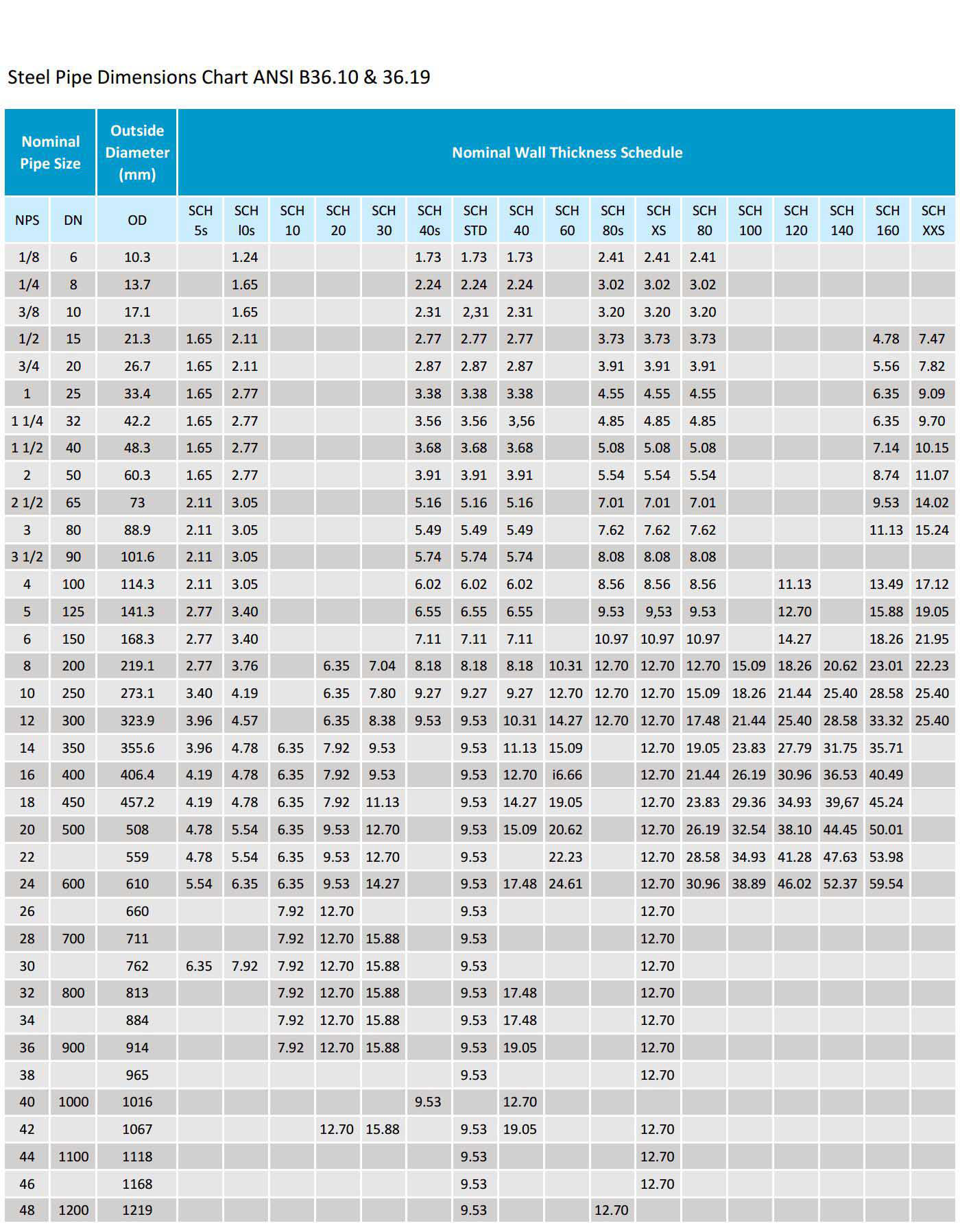Steel pipe size standard to avoid the wrong size when we buy steel pipe

In daily transactions, the most likely problem is the communication of steel pipe size. How to effectively and correctly express the size of steel pipe we need to buy has become the most important topic.
So, what are the exactly right ways to express the steel pipe dimensions?
For your better understanding, we will explain from below aspects:
3 characters for a pipe dimension Dimension Standards of carbon and stainless steel pipe (ASME B36.10M & B36.19M) Pipe Size Schedule (Schedule 40 & 80 steel pipe means) Means of Nominal Pipe Size (NPS) and Nominal Diameter (DN) Steel Pipe Dimension Chart (Size chart) Pipe Weight Class Schedule (WGT)
And finally, we will tells you how to describe steel pipe dimensions & sizes correctly.
Steel Pipe Dimension A completely description for steel pipe dimension includes outer diameter (OD), wall thickness (WT), pipe length (Normally 20 ft 6 meter, or 40 ft 12 meters).
Through these characters we could calculate the pipe weight, how much pressure pipe could bear, and the cost per foot or per meter.
Therefore, that’s why we always need to know a right pipe size.
Steel Pipe Dimensions Chart (Size Chart)
Pipe Schedule Chart unit in mm as below, view here for Pipe Schedule Chart in inch.
Steel Pipe Dimensions Chart according to ANSI B36.10 and ANSI B36.19
Dimension standards for steel pipe There are different standards to describe the steel pipe size, OD and wall thickness. Mainly are ASME B 36.10, ASME B 36.19.
Relevant standard specification ASME B 36.10M and B 36.19M Both ASME B36.10 and B36.19 are the standard specification for the dimensions of the steel pipe and accessories.
ASME B36.10M The standard covers the standardization of steel pipe dimensions and sizes. These pipes includes seamless or welded types, and applied in high or low temperature and pressures. The pipe distinguished from tube (Pipe vs Tube), here the pipe is specially for pipeline systems, fluids (Oil and gas, water, slurry) transmissions. Use the standard of ASME B 36.10M. In this standard, the pipe Outer Diameter smaller than 12.75 in (NPS 12, DN 300), pipe actual diameters is larger than NPS (Nominal Pipe Size)or DN (Nominal Diameter).
On the hand, for steel tube dimensions, the actual outside diameter same with pipe number for all sizes.
Why pipe size smaller to NPS 12 (DN 300) have different OD First, we need to admit that all pipe size should be identified as nominal pipe size (NPS).
Second, for NPS 1/8 (DN 6) to NPS 12 (DN 300), these are based on a standard outside diameter (O.D.) This O.D. was originally selected to specify pipe dimension, but as the pipe always have an wall thickness and internal diameter (ID). For small pipe, there is a different size between OD and ID (Wall thickness), but as the pipe dimensions became larger, the OD and ID approximately to become equal.
As there is no such relation between the old standard thickness (O.D.) and Nominal Size, so both of them accepted by standard ASME B 36.10 M.
Steel Pipe Schedule In ASME B36.10M, Pipe schedule identified as Standard (STD), Ex-Standard (XS), or Double Extra Strong(XSS); Or with Schedule No. 5, 10, 20, 30, 40, 80, 120, 160.
ASME B36.19M ASTM B36.19M is for the stainless steel pipe dimensions, included seamless and welded types as the same.
This dimension standard mostly is same with ASTM B36.10M. Wherever the different part is: a. For NPS 14 to NPS 22 (DN 350-550), schedule 10S; b. NPS 12 of Schedule 40S c. NPS 10 and 12 of schedule 80S.
Above mentioned pipe thickness is different with B36.10M, so suffix “S” is used here.
Ways of express pipe dimensions 1. For Pipe wall thickness: Use Steel Pipe Schedule, like schedule 40 steel pipe, schedule 80 pipe. 2. For pipe Diameters: Nominal Pipe Size (NPS) and DN (Nominal Diameter) 3. Pipe weight Class (WGT), LB/FT (Pounds per foot), KG/M (Kg per meter)
What is Steel Pipe Dimensions Schedule? Steel pipe schedule is a indicating method represented by ASME B 36.10, and also used in many other standards, marked with “Sch”. Sch is the abbreviation of schedule, generally appearing in the American steel pipe standard, which is a prefix of a series number. For example, Sch 80, 80 is a pipe number from chart/table ASME B 36.10.
“Since the steel pipe main application is to transport the fluids under pressure, so their internal diameter is their critical size. This critical size is taken as nominal bore (NB). Therefore, if steel pipe carry the fluids with pressure, it is very important that pipe shall have enough strength and enough wall thickness. So wall thickness is specified in Schedules, which means the pipe schedule, abbreviated as SCH. Here ASME is the given standard and definition for the pipe schedule.”
The pipe schedule formula: Sch.=P/[ó]t×1000 P is the Designed pressure, units in MPa;[ó]t is Allowable stress of materials under design temperature, Units in MPa.
What does SCH mean for the steel pipe dimensions As describing the steel pipe parameter, we usually use the pipe schedule, It is a method that represent pipe wall thickness with number. Pipe schedule ( sch. ) is not a wall thickness, but a wall thickness series. Different pipe schedule means different wall thickness for the steel pipe in the same diameter. The most frequently indications of schedule are SCH 5, 5S, 10, 10S, 20, 20S, 30, 40, 40S, 60, 80, 80S, 100, 120, 140, 160. The larger the table number, the thicker the surface pipe wall, the higher the pressure resistance.
Schedule 40, 80 steel pipe dimension means If you are new in pipe industry, why you always see a schedule 40 or 80 steel pipe everywhere? What kind of material for these pipes?
As you have read above articles you know that Schedule 40 or 80 represent a pipe wall thickness, but why it always been searched by buyers?
Here is the reason:
Schedule 40 and 80 steel pipe as the common sizes that required in different industries, because of the generally pressure these pipes bear, they are always been asked for a large quantity.
The material standard for such thickness pipes has no limitations, you could ask sch 40 stainless steel pipe, like ASTM A312 Grade 316L; Or sch 40 carbon steel pipe, such as API 5L, ASTM A53, ASTM A106B, A 179, A252, A333 etc..
What is the Nominal Pipe Size (NPS)? Nominal Pipe Size (NPS) is a North American set of standard sizes for pipes used for high or low pressures and temperatures. Pipe size is specified with two non-dimensional numbers: a nominal pipe size (NPS) based on inches, and a schedule (Sched. or Sch.).
What is DN (Nominal Diameter) Nominal diameter also mean outside diameter. Because as the pipe wall is very thin, the outside and inside diameter of the steel pipe is almost same, so the average value of the both parameters is used as the name of the pipe diameter. DN (nominal diameter) is the general diameter of various pipe and pipeline accessories. The same nominal diameter of the pipe and pipe fittings can be interconnected, it has interchangeability. Although the value is close or equal to inside diameter of pipe, It is not the actual sense of the pipe diameter. The nominal size is represented by a digital symbol followed by the letter “DN”, and mark the unit in millimeters after the symbol. For example, DN50, a pipe with a nominal diameter of 50 mm.
DN (mm) and NPS (inch) conversion Nominal diameter DN (mm) and NPS (inch) conversion
1. Conversion DN ( mm ) that requires separate memory
3. Exact conversion 1 inch =25.4 mm
Pipe Weight Class Schedule WGT class (weight class) is an indication of the pipe wall thickness in early, but still used. It has only three grades, namely STD ( standard ), XS ( extra strong ), and XXS ( double extra strong ). For the earlier production pipe, each caliber has only one specification, called standard tube (STD). In order to deal with high pressure fluid, the thickening pipe (XS) appeared. XXS ( double extra strong ) pipe appeared to handle the higher pressure fluid. People began to require the use of more economical thin-walled pipe until the emergence of new materials processing technology, then gradually appeared the above pipe number. The corresponding relation between pipe schedule and weight class, refer to ASME B36.10 and ASME B36.19 specification.
How to describe steel pipe dimensions and size correctly? For example: a. Expressed as “pipe outside diameter × wall thickness”, such as Φ 88.9mm x 5.49mm (3 1/2” x 0.216” ). 114.3mm x 6.02mm (4 1/2” x 0.237”), length 6m (20ft) or 12m (40ft), Single Random Length (SRL 18-25ft), or Double Random Length (DRL 38-40ft).
b. Expressed as “NPS x Schedule”, NPS 3 inch x Sch 40, NPS 4 inch x Sch 40. Same size as above specification.
c. Expressed as “NPS x WGT Class”, NPS 3 inch x SCH STD, NPS 4 inch x SCH STD. Same size above.
d. There is another way, in North America and South America, usually use “Pipe Outer Diameter x lb/ft” to describe pipe size. As OD 3 1/2”, 16.8 lb/ft. lb/ft is pound per feet.
Classification navigation:
1、Alloy steel pipe 2、Stainless steel tube 3、Stainless steel welded pipe 4、Reducing pipe
5、High Pressure Thick Wall Pipe Fitting 6、Elbow 7、Flange 8、Spigot Pipe Fitting
9、Tee 10、Tube Cap 11、Pipe Fitting















